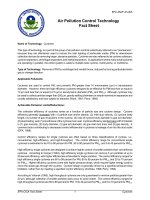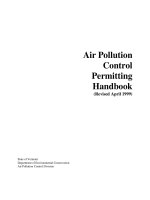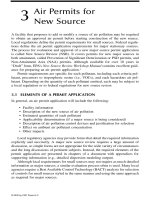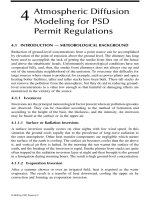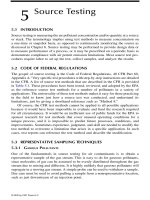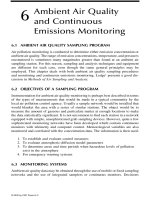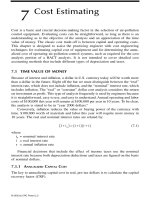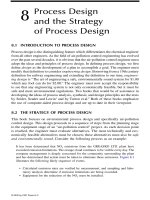AIR POLLUTION CONTROL TECHNOLOGY HANDBOOK - CHAPTER 13 pps
Bạn đang xem bản rút gọn của tài liệu. Xem và tải ngay bản đầy đủ của tài liệu tại đây (3.62 MB, 17 trang )
Thermal Oxidation
for VOC Control
Volatile organic compounds (VOCs) generally are fuels that are easily combustible.
Through combustion, which is synomonous with thermal oxidation and incincera-
tion, the organic compounds are oxidized to CO
2
and water, while trace elements
such as sulfur and chlorine are oxidized to species such as SO
2
and HCl.
Three combustion processes that control vapor emissions by destroying collected
vapors to prevent release to the environment are (a) thermal oxidation — flares,
(b) thermal oxidation and incineration, and (c) catalytic oxidation. Each of these
processes has unique advantages and disadvantages that require consideration for
proper application. For example, flares are designed for infrequent, large volumes
of concentrated hydrocarbon emissions, while thermal oxidizers are designed for
high-efficiency treatment of continuous, mixed-hydrocarbon gas streams, and cata-
lytic oxidizers are designed to minimize fuel costs for continuous, low-concentration
emissions of known composition. The design of the basic processes can be modified
for specific applications, resulting in the overlap of the distinctions between pro-
cesses. For example, ground flares are basically thermal oxidizers without heat
recovery that frequently are used for intermittent flow of relatively low volumes of
concentrated VOC streams.
13.1 COMBUSTION BASICS
As every Boy Scout, Girl Scout, and firefighter knows, combustion requires the three
legs of the fire triangle illustrated in Figure 13.1. The oxidizer and fuel composition,
i.e., air-to-fuel ratio, is critical to combustion. If the fuel concentration in air is below
the Lower Flammability Limit (LFL), also known as the Lower Explosive Limit
(LEL), the mixture will be too lean to burn. If it is above the Upper Flammability
Limit (UFL), it will be too rich to burn. Fuels with a wide range of flammability
limits burn more easily than those with a narrow range. With a narrow range, the
flame is more unstable since the interior of the flame can easily be starved for air.
The heating value of the fuel — the amount of heat released by the combustion
process — is determined by the heat of combustion and the concentration of the
hydrocarbons in the gas stream. Values for the heat of combustion for common
organic compounds are provided in Table 13.1. The heat of combustion is the same
as the heat of reaction for the oxidation reaction, and therefore can be calculated
from the heats of formation of the reactants and products. It is the net chemical
energy that is released by the oxidation reaction when the reactants begin at 25ºC
and after the reaction products are cooled to 25ºC. That the reactants are first heated
to the ignition temperature and the exhaust gases are hot does not affect the value
13
9588ch13 frame Page 191 Wednesday, September 5, 2001 9:55 PM
© 2002 by CRC Press LLC
for the heat of combustion, because the value includes the energy recovered by
cooling the exhaust gases. Indeed, the “higher heating value” includes the energy
recovered when water vapor is condensed to liquid at 25ºC, while the lower heating
value is based on water remaining in the gaseous state.
The flame temperature is determined by a heat balance including the energy
produced by combustion, absorbed by the reactant gases, released to the exhaust
gases, and lost to the surroundings by radiation. Therefore, factors such as the
combustion air temperature, composition of the exhaust gases, and configuration of
the combustion chamber affect the peak flame temperature.
Despite exposure to flame in the presence of oxygen, not all of a hydrocarbon
pollutant will react. The destruction efficiency of VOC pollutants by combustion
depends on the three Ts: temperature (typically 1200 to 2000ºF), time (typically 0.2
to 2.0 s at high temperature), and turbulence. The required destruction efficiency
often is expressed as 9s. Two 9s is 99% destruction efficiency, and five 9s is 99.999%
destruction efficiency. Some VOCs burn easily and do not require extremely high
destruction efficiency. Others, especially chlorinated hydrocarbons, do not burn as
easily, and the required high destruction efficiency demands a good combination of
high temperatures, adequate residence time at high temperature, and turbulence to
promote mixing for good combustion of the entire gas stream. Table 13.2 lists the
relative destructability for some common VOCs.
13.2 FLARES
Flaring is a combustion process in which VOCs are piped to a remote location and
burned in either an open or an enclosed flame. Flares can be used to control a wide
variety of flammable VOC streams, and can handle large fluctuations in VOC con-
centration, flow rate, and heating value. The primary advantage of flares is that they
have a very high turndown ratio and rapid turndown response. With this feature,
they can be used for sudden and unexpected large and concentrated flow of hydro-
carbons such as safety-valve discharges as well as venting-process upsets, off-spec
product, or waste streams.
FIGURE 13.1
“Fire triangle.”
9588ch13 frame Page 192 Wednesday, September 5, 2001 9:55 PM
© 2002 by CRC Press LLC
Flares cannot be used for dilute VOC streams, less than about 200 BTU/scf,
without supplemental fuel because the open flame cannot be sustained. Adding
supplemental fuel, such as natural gas or propane, increases operating cost. Flam-
mable gas sensors can be used to regulate supplemental fuel.
TABLE 13.1
Heat of Combustion for Various Compounds
Compound
Lower Heating Value
(BTU/lb)
Acetaldehyde 10,854
Acetone 12,593
Acetylene 20,776
Ammonia 7992
Benzene 17,446
Butane 19,697
Carbon monoxide 4347
Chlorobenzene 11,772
Chloroform 1836
Cyclohexane 18,818
Dichloroethane 4990
Ethane 20,432
Ethanol 12,022
Ethylbenzene 17,779
Ethylene 20,295
Ethylene dichloride 5221
Ethylene glycol 7758
Formaldehyde 7603
Heptane 19,443
Hexane 19,468
Hydrogen 51,623
Hydrogen sulfide 6545
Methane 21,520
Methanol 9168
Methyl ethyl ketone 13,671
Methylene chloride 2264
Naphthalene 16,708
Octane 19,227
Pentane 19,517
Phenol 13,688
Propane 19,944
Propylene 19,691
Styrene 17,664
Toluene 17,681
Trichloroethane 3682
Trichloroethylene 3235
Vinyl chloride 8136
Xylene 17,760
9588ch13 frame Page 193 Wednesday, September 5, 2001 9:55 PM
© 2002 by CRC Press LLC
13.2.1 E
LEVATED
, O
PEN
F
LARE
The commonly known flare is the elevated, open type. Elevated, open flares prevent
potentially dangerous conditions at ground level by elevating the open flame above
working areas to reduce the effects of noise, heat, smoke, and objectionable odors.
The elevated flame burns freely in open air. A simplified flow schematic of an
elevated, open flare system is shown in Figure 13.2. The typical system consists of
TABLE 13.2
Relative Destructability of VOC
Pollutants by Combustion
VOC
Relative
Destructability
Alcohols High
Aldehydes
Aromatics
Ketones
Acetates
Alkanes
Chlorinated hydrocarbons Low
FIGURE 13.2
Simplified flare schematic.
9588ch13 frame Page 194 Wednesday, September 5, 2001 9:55 PM
© 2002 by CRC Press LLC
a header to collect waste gases, some form of assist to promote mixing (frequently
steam is used), and an elevated burner tip with a pilot light. A typical burner tip is
shown in Figure 13.3. Atmospheric combustion air is added by turbulence at the
burner tip.
Although flares have a very high turndown velocity, exit velocity extremes
determine the size of the flare tip. Maximum velocities of 60 ft/s and 400 ft/s are
used for waste streams with heating values of 300 BTU/scf and 1,000 BTU/scf,
respectively, to prevent blowout of the flame. A correlation for maximum velocity
with heating value is provided by Equation 13.1:
(13.1)
where
V
max
= maximum velocity, ft/s
B
v
= net heating value, BTU/scf
The design volumetric flow should give 80% of the maximum velocity.
FIGURE 13.3
Steam assisted smokeless flare tip. (Courtesy of Flare Industries, Inc.)
log
max10
1214
852
V
B
v
()
=
+
()
9588ch13 frame Page 195 Wednesday, September 5, 2001 9:55 PM
© 2002 by CRC Press LLC
13.2.2 S
MOKELESS
F
LARE
A
SSIST
Mixing and complete combustion can be improved at the flare tip either by steam-
assist, air-assist, or pressure-assist mechanisms. As shown in Figure 13.4, the sup-
plemental assist can have a dramatic positive effect on preventing the production of
black smoke.
A large part of the effect can be attributed to turbulence that draws in combustion
air. The water molecules in steam-assisted flare headers may contribute additional
benefits. They may separate hydrocarbon molecules which would prevent polymer-
ization and formation of long-chained oxygenated compounds that burn at a reduced
rate. And they may react directly with hot carbon particles through the water–gas
reaction, forming CO, CO
2
, and H
2
from soot.
FIGURE 13.4
Steam-assisted flare: (a) steam off, (b) steam on. (Courtesy of John Zink
Company, LLC.)
9588ch13 frame Page 196 Wednesday, September 5, 2001 9:55 PM
© 2002 by CRC Press LLC
Steam typically is added at a rate of 0.01 to 0.6 lb steam per lb of vented gas,
depending on the carbon content of the flared gas. Typical refinery flares use about
0.25 lb steam per lb of vent gas, while many general VOC streams use about 0.4 lb
steam per lb of vent gas. A useful correlation is 0.7 lb steam per lb of CO
2
in the flared gas.
Steam assist can produce a loud, high-frequency (above 355 Hz) jet noise in
addition to the noise produced by combustion. Noise is reduced by using multiple
small jets and by acoustical shrouding.
Air assist is accomplished by using a fan to blow air into an annulus around the
flare gas stack center channel. The turbulent air is then mixed at the burner tip. Due
to the fan power requirement, air assist is not economical for high gas volumes, but
is useful where steam is not available.
Pressure assist relies on high pressure in the flare header and high pressure drop
at the burner tip. This approach cannot be used with variable flow, greatly reducing
the number of viable applications.
13.2.3 F
LARE
H
EIGHT
The required height of an elevated, open flare is determined primarily by limitation
on thermal radiation exposure, although luminosity, noise, dispersion of combustion
products, and dispersion of vented gases during flameout also are considerations.
The maximum heat intensity for a very limited exposure period of 8 s is 1500 to
2000 BTU/h-ft
2
. This may give one just enough time to seek shelter or quickly
evacuate the area. Most flares are designed for extended exposure at a maximum
heat intensity of 500 BTU/h-ft
2
. The distance from the center of the flame to an
exposed person is determined using Equation 13.2:
(13.2)
where
D = distance from center of flame, ft
τ
= fraction of radiated heat that is transmitted (assume 1.0, but could be less for
smoky or foggy conditions)
F = fraction of heat that is radiated, function of gas composition, burner diameter,
and mixing (typical values are 0.1 for H
2
in a small burner to 0.3 for C
4
H
10
in a large burner)
R = net heat release, BTU/h
K = allowable radiation, BTU/h-ft
2
The distance from the center of the flame to an exposed person takes into account
not only the height of the flare tip, but also the length of the flame and the distortion
of the flame in windy conditions. The length of the flame is determined by:
(13.3)
where L = flame length, feet
D
FR
K
2
4
=
τ
π
log . log .
10 10
0 457 2 04LR=
()
−
9588ch13 frame Page 197 Wednesday, September 5, 2001 9:55 PM
© 2002 by CRC Press LLC
Elevated flare stacks typically are supported in one of three ways: (1) self-
supporting; (2) guy-wires; and (3) derrick. Self-supported stacks tend to be smaller,
shorter stacks of about 30 to 100 ft, although stacks of 200 ft or more are possible,
depending on soil conditions and the foundation design. Tall stacks can be supported
more economically with the aid of guy-wires. Gas piping temperature fluctuations
that cause expansion and contraction must be considered. A derrick structure is
relatively expensive, but can be used to support the load of a very tall stack.
13.2.4 G
ROUND
F
LARE
It is possible to enclose a flare tip with a shroud and bring it down to ground level.
In an enclosed ground flare, the burners are contained within an insulated shell. The
shell reduces noise, luminosity, heat radiation, and provides wind protection. These
devices also are known as once-through thermal oxidizers without heat recovery.
This type of flare often is used for continuous-flow vent streams but can be used for
intermittent or variable flow streams when used with turndown and startup/shutdown
controls. A common application is vapor destruction at fuel loading terminals where
the vapor flow is intermittent, but predictable.
Enclosed ground flares provide more stable combustion conditions (temperature,
residence time, and mixing) than open flares because combustion air addition and
mixing is better controlled.
Maintenance is easier because the flare tip is more accessible. But a disadvantage
is that ground flares cannot be used in an electrically classified area because it creates
an ignition source at ground level.
Temperatures are generally controlled within the range of 1400 to 2000°F using
air dampers. They may use single or multiple burner tips within a refractory-lined
steel shell. Multiple burners allow the number of burners in use to be staged with
the gas flow. Staging can be accomplished by using liquid seal diplegs at different
depths or by using pressure switches and control valves.
A ground flare enclosure that contains multiple burner tips typically is sized for
about 3 to 4 million BTU per hour per square foot of open area within the refractory
lining of the enclosure.
1
The height of the enclosure depends on the flame length,
which is a function of a single burner size, rather than the total heat release. A typical
height for 5 MMBTU/h burner tips is about 32 ft.
13.2.5 S
AFETY
F
EATURES
Flashback protection must be provided to avoid fire or explosion in the flare header.
Protection is provided by keeping oxygen out of the flare header using gas seals,
water seals, and/or purge gas, and by using flame arrestors and actuated check valves.
Gas seals keep air from mixing with hydrocarbons in the vertical pipe of an
elevated flare. Two types of gas seals, a dynamic seal and a density seal, are shown
in Figure 13.5.
A density or molecular seal forces gas to travel both up and down to get through
the seal, like a P-trap water seal, and high-density (high-molecular weight) gas
cannot rise through low-density gas in the top of the seal. A low purge flow of natural
9588ch13 frame Page 198 Wednesday, September 5, 2001 9:55 PM
© 2002 by CRC Press LLC
gas, less than 1 ft/s, ensures that the gas in the top of the seal is more buoyant than
air, and can keep the oxygen concentration in the stack below 1% with winds up to
20 mph. Density seals are recommended in larger flares with tips greater than 36 in.
diameter.
2
A dynamic gas seal is designed to provide low resistance to upward flow and
high resistance to air flowing downward. Natural gas can be used for purge flow at
about 0.04 ft/s to keep the oxygen concentration in the flare stack below 6%. Nitrogen
also can be used as purge gas, and eliminates the possibility of burn-back into the
flare tip at low flow rates.
After high-temperature gas is flared, the stack is filled with hot gas that will
shrink upon cooling, and that can tend to draw air into the stack. The purge flow
compensates for the reduction in volume, and the required purge rate may be
governed by the rate of cooling during this period.
Flame arrestors and liquid-seal drums also are used to prevent flashback into
the flare header. Liquid-seal drums have the advantage of avoiding the potential for
being plugged by any liquids that might collect and congeal in the system. And they
can be used as a back-pressure device to maintain positive pressure in the flare
header. A disadvantage is the possibility of freezing if the liquid seal contains water.
Steam coils can be used to heat the seal.
Hydrocarbon liquids must be kept out of flare stacks to prevent burning liquid
droplets from being emitted from the stack. Knockout drums are used to separate
and collect any liquid droplets larger than about 300 to 600
µ
m before gases are
sent to the flare. They may be of either horizontal or vertical design. Generally,
knockout drums are designed based on American Petroleum Institute (API) Recom-
mended Practices.
3
FIGURE 13.5
Types of gas seals. (Courtesy of Flare Industries, Inc.)
9588ch13 frame Page 199 Wednesday, September 5, 2001 9:55 PM
© 2002 by CRC Press LLC
13.3 INCINERATION
An incinerator, or to be politically correct, a thermal oxidizer, burns VOC-containing
gas streams in an enclosed refractory-lined chamber that contains one or more
burners. The incoming waste hydrocarbon vapor can be co-fired with natural gas or
propane to maintain consistently high oxidation temperatures. A ground flare is one
type of incinerator. Discussed below are thermal oxidizers that are designed for high
destruction efficiency with heat recovery built-in to reduce fuel consumption cost.
Heat recovery may be achieved with recuperative heat exchangers, with a regener-
ative design that employs ceramic beds, or by heating process fluids or generating
steam.
An advantage of thermal oxidation in an incinerator is the high destruction
efficiency that can be obtained by proper control of the combustion chamber design
and operation. If temperatures are maintained above 1800°F, greater than 99%
hydrocarbon destruction is routinely achievable.
4
This efficiency is due to the
increased residence time, consistently high temperature, and thorough mixing (the
three Ts: time, temperature, and turbulence) in the combustion chamber.
Thermal oxidizers can be costly to install because of required support equipment,
including high pressure fuel supplies (for example, natural gas), and substantial
process-control and monitoring equipment. In addition, public perception of a new
“incinerator” can make it difficult to locate and permit a new unit.
13.3.1 R
ECUPERATIVE
T
HERMAL
O
XIDIZER
A recuperative thermal oxidizer uses a shell-and-tube type heat exchanger to recover
heat from the exhaust gas and preheat the incoming process gas, thereby reducing
supplemental fuel consumption. A schematic of a recuperative thermal oxidizer is
shown in Figure 13.6. Recuperative heat exchangers with a thermal energy recovery
efficiency of up to 80% are in common commercial use.
13.3.2 R
EGENERATIVE
T
HERMAL
O
XIDIZER
A regenerative thermal oxidizer uses ceramic beds to absorb heat from the exhaust
gas and uses the captured heat to preheat the incoming process gas stream. Destruc-
tion of VOCs is accomplished in the combustion chamber, which is always fired and
kept hot by a separate burner. This system provides very high heat recovery of up
to 98%, and can operate with very lean process gas streams because supplemental
heat requirements are kept to a minimum with the high heat recovery. The gas steam
may contain less than 0.5% VOC, and have a low heat value of less than 10 BTU/scf.
A two-chamber regenerative thermal oxidizer in shown schematically in
Figure 13.7. The incoming process gas passes through the warm ceramic bed and
is preheated to almost the temperature of the combustion chamber. Figure 13.7 shows
a typical inlet gas temperature of 100ºF exiting the first chamber at approximately
1430ºF. The combustion chamber provides time, temperature, and turbulence, with
the combusted gases exiting at approximately 100 to 170ºF through the second
ceramic bed. Heat is recovered in the second ceramic bed. When the process gas
exit temperature reaches approximately 170ºF, valves switch the direction of flow
9588ch13 frame Page 200 Wednesday, September 5, 2001 9:55 PM
© 2002 by CRC Press LLC
so that the incoming gas passes through the freshly warmed bed. By cycling the
valves quickly, as often as every 30 to 120 s, the temperature fluctuation at any point
within the bed does not exceed about 70° throughout each cycle. This requires large,
FIGURE 13.6
Recuperative thermal oxidizer flow schematic.
FIGURE 13.7
Two-chamber regenerative flow schematic.
9588ch13 frame Page 201 Wednesday, September 5, 2001 9:55 PM
© 2002 by CRC Press LLC
rapid-cycling valves and extensive ductwork. The valves must be designed for very
low leakage since any leakage contaminates the treated exhaust gases with untreated
process gas. Critical high-efficiency systems use zero-leakage valves with an air
purge between double-seal surfaces.
If the VOC emissions from a two-chamber bed are measured, the concentration
would vary as shown in Figure 13.8. Intermittent spikes in the VOC concentration
would occur each time the valves switch the direction of flow, because untreated
process gas would be present in the inlet bed when it is suddenly switched to the
outlet. This reduces the overall VOC destruction efficiency.
To overcome this problem, a third bed is used. This allows a purge step to sweep
untreated process gas out of an inlet bed before it is switched to become an outlet
bed. A schematic of the three-chamber design is shown in Figure 13.9. This figure
shows that the purge gas can be treated process exhaust gas, which will be free of
VOC. Large and small three-chamber designs are shown in Figures 13.10 and 13.11.
Figure 13.12 shows a seven-chamber regenerative thermal oxidizer. Five- and
seven-chamber oxidizers are used not to improve VOC destruction efficiency, but to
increase capacity. Three beds are switched at a time with half of the beds serving
as inlet and half as outlet beds, while the odd bed is being purged. The multiple
beds are designed and sized for ease of transport and construction.
The ceramic material is frequently made up of ceramic saddles of the same type
that are used as packing material in packed scrubbers. Figure 13.13 shows random
packing being loaded into a new bed. Random packing is less expensive and easier
to install compared to structured ceramic packing. But structured ceramic packing,
as shown in Figure 13.14, can be used and exhibits lower pressure drop and a lower
propensity to fouling with particulate that may be in the process gas. Structured
packing is made from blocks of ceramic material that contain multiple gas passages.
It can provide up to 67% higher bulk density and up to 440% higher surface area
FIGURE 13.8
Two-chamber regenerative oxidizer emissions.
9588ch13 frame Page 202 Wednesday, September 5, 2001 9:55 PM
© 2002 by CRC Press LLC
than random packing, making structured packing a superior heat storage and heat
transfer material. Lower pressure drop results from laminar flow through the struc-
tured passages. With a superficial inlet velocity of 5.0 ft/s, structured packing pro-
vides a pressure drop of about 1.7 in. H
2
O per foot, as compared to approximately
5 in. H
2
O per foot of random packing. And the pressure drop variation with flow is
linear with structured packing. The lower pressure drop reduces fan power cost or
can be exploited to make a larger ceramic bed for more efficient thermal energy
recovery.
5
FIGURE 13.9
Three-chamber regenerative flow schematic.
FIGURE 13.10
Three-chamber regenerative thermal oxidizer. (Courtesy of Smith Environ-
mental Corp.)
9588ch13 frame Page 203 Wednesday, September 5, 2001 9:55 PM
© 2002 by CRC Press LLC
13.3.3 R
ECUPERATIVE
VS
. R
EGENERATIVE
D
ESIGN
S
ELECTION
Recuperative heat recovery tends to be less efficient, but less expensive to install,
than regenerative heat recovery. Therefore, it is most economical to use this type of
heat recovery for small systems with more concentrated VOC gas streams that have
a high heating value. Once again, the most economical unit is the classic tradeoff
of operating vs. capital cost. The cost factors that must be considered include:
• Equipment capital cost
• Installation cost
• Auxiliary fuel costs, based on thermal efficiency
FIGURE 13.11
Small three-chamber regenerative thermal oxidizer. (Courtesy of Smith Envi-
ronmental Corp.)
FIGURE 13.12
Seven-chamber regenerative thermal oxidizer. (Courtesy of Smith Environ-
mental Corp.)
9588ch13 frame Page 204 Wednesday, September 5, 2001 9:55 PM
© 2002 by CRC Press LLC
• Fan power, based on pressure drop and gas flow
• Maintenance costs, affected by valve cycling and fouling of the heat
exchanger or packing
13.4 CATALYTIC OXIDATION
Like flares and incinerators, catalytic oxidation units destroy hydrocarbon vapors
via thermal oxidation, but at lower temperatures with the assistance of a catalyst
that promotes oxidation. This reduces fuel requirements and operating costs for
catalytic oxidation systems. It also reduces NO
x
emissions from the combustion
process, and CO emissions are low, too, because CO oxidation is promoted by the
catalyst.
FIGURE 13.13
Loading random media. (Courtesy of Smith Environmental Corp.)
FIGURE 13.14
Installing structured media. (Courtesy of Geoenergy International Corp.)
9588ch13 frame Page 205 Wednesday, September 5, 2001 9:55 PM
© 2002 by CRC Press LLC
Typical operating temperatures of catalytic incinerators range from 400 to 650°F
for heavy hydrocarbons (C
4
and above), 700 to 1000°F for light hydrocarbons (C
3
and
below), and 400 to 900°F for halogenated hydrocarbons. Because of the lower oper-
ating temperatures, the system enclosure may not require the rugged refractory lining
needed for a high-temperature combustion chamber. Stainless steels are recommended
for interior surfaces and parts exposed to preheat and oxidizer temperatures.
6
Catalytic oxidation units may incorporate a recuperative heat exchanger for heat
recovery to save additional fuel cost. A typical system consists of a hot gas heat
exchanger, a thermal preheat zone with a standard burner, and a catalyst bed as
shown in Figure 13.15.
Catalytic incinerators are most effective at treating low concentration vapor
streams, less than one percent by volume, of known composition. Treating higher
concentration vapor streams can overheat and deactivate the catalyst. Dilution of the
vapor stream may be required to lower the vapor concentration to below the LEL
before treatment by catalytic oxidation as well as to provide a heat sink to prevent
overheating. Mixed hydrocarbon vapors from miscellaneous sources often contain
something that will affect the catalyst, and frequently have highly variable heating
values.
Noble metals such as platinum and palladium may be used as catalysts for VOC
oxidation. They may be applied to a ceramic or metal substrate with an alumina
washcoat. Metal oxides, including chromia/alumina, cobalt oxide, and copper
oxide/manganese oxide also are used. Each type of catalyst has an optimum tem-
perature range in which it is effective. Generally, precious metal catalysts are opti-
mized for VOC oxidation at higher temperatures than metal oxide catalysts.
FIGURE 13.15
Typical catalytic oxidation system.
9588ch13 frame Page 206 Wednesday, September 5, 2001 9:55 PM
© 2002 by CRC Press LLC
Catalysts supported on a fixed substrate are less susceptible to attrition, thermal
shock, and catalyst carryover than catalyst in packed or fluidized beds, and the
substrate stucture provides relatively low pressure drop, less than 0.5 in. H
2
O per
inch of bed depth. Catalyst pellets in packed beds can have a pressure drop of 8 to
80 in. H
2
O per inch of bed depth, but allow easy replacement when placed on shallow
trays. Fluidized catalyst beds provide uniform heating and high surface area for
catalyst activity and avoid the potential for catalyst blinding when particulate is in
the process gas.
Precious metal catalysts are sensitive to contaminants in the feed streams and
can be poisoned easily. Lead, zinc, mercury, arsenic, phosphorous, bismuth, anti-
mony, iron oxide, and tin are potential poisons to catalysts. Halogens, sulfur com-
pounds, and NO
2
are potential chemical inhibitors, although some inhibitors can be
removed by washing with acid or alkaline solutions. Particulate can collect on fixed
bed catalyst and blind or mask the active sites. Sometimes compressed air or steam
is used to blow off the catalyst surface. Also, heavy hydrocarbons (even in small
amounts) will tend to deposit on fixed catalyst, causing deactivation by masking.
Some heavy hydrocarbons and even coke dust can be burned off of the catalyst
surface to reactivate it. Eventually, the catalyst will have to be replaced. Typical
catalyst life can be expected to be 2 to 5 years.
Catalytic oxidation can be used as a “polishing” step, following a recovery unit
(e.g., lean oil absorption or other VOC control system) which removes the majority
of the hydrocarbon. Given a constant flow of low-concentration vapor feed material,
catalytic incinerators can provide economical high-efficiency VOC destruction.
REFERENCES
1. Leite, O. C., Safety, noise, and emissions elements round out flare guidelines,
Oil
Gas J.
, 24, 68, 1992.
2. Leite, O. C., Design alternatives, components key to optimum flares,
Oil Gas J.
, 23,
70, 1992.
3. American Petroleum Institute,
Guide for Pressure-Relieving and Depressuring Sys-
tems, API Recommended Practice 521
, 4th ed., Washington, D.C., 1997.
4. U.S. Environmental Protection Agency,
Handbook — Control Technologies for Haz-
ardous Air Pollutants
, EPA-625-6-91-014, Research Triangle Park, NC, 1991.
5. Pitts, D. M., Regenerative thermal oxidizers: structured packing improves perfor-
mance,
Chem. Eng.
, 106(1), 113, 1999.
6.
Clean Air Compliance Handbook
, Megtec Systems, DePere, WI, 1998.
9588ch13 frame Page 207 Wednesday, September 5, 2001 9:55 PM
© 2002 by CRC Press LLC
